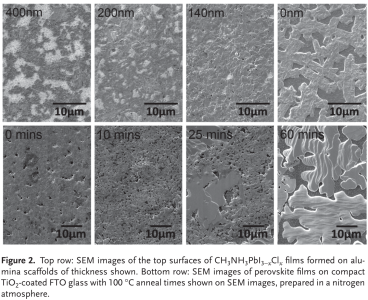Organometal halide perovskite (OMHP) is hardly a household name, but this new material is the source of much interest, not least for Oxford Applied Mathematicians Victor Burlakov and Alain Goriely as they model the fabrication and operation of solar cells.
One of the main advantages of OMHP is that the thin films on its base can be produced in a very inexpensive way via a solution deposition with subsequent heat treatment at moderate temperatures. Victor and Alain developed a generic theoretical framework for calculating surface coverage by a solid film of material de-wetting on the substrate. Using experimental data from OMHP thin films as an example, they calculated surface coverage for a wide range of annealing (heating) temperatures and film thicknesses. Their model accurately reproduced solution-cast thin film coverage (see the figure) and identified methods for both high and low levels of surface coverage.
Expanding their research Victor and Alain have also looked at the kinetics of photo-generated charge carriers in OMHP. By modelling the time decay of photoluminescence in the material, they extracted important information about charge carrier lifetime and concentration of intrinsic point defects. The latter are highly detrimental for the photo-voltaic performance of OMHP. The models, together with the experimental studies of colleagues, clarified the origin of the point defects and consequently identified a means of significantly decreasing their concentration.
Victor and Alain’s research can be explored in more detail on Victor and Alain's homepages. Their work reiterates the central importance of mathematical modelling in addressing real world problems.


